Sugar snap peas make a lovely addition to any garden. They aren’t too challenging to grow and when sugar snap peas are ready for the dinner table, they provide an excellent source of vitamin K and other nutrients.
If your sugar snap peas are being eaten and terrorized by some unknown pest, like mine was a few seasons ago, I have answers and solutions to your problem.
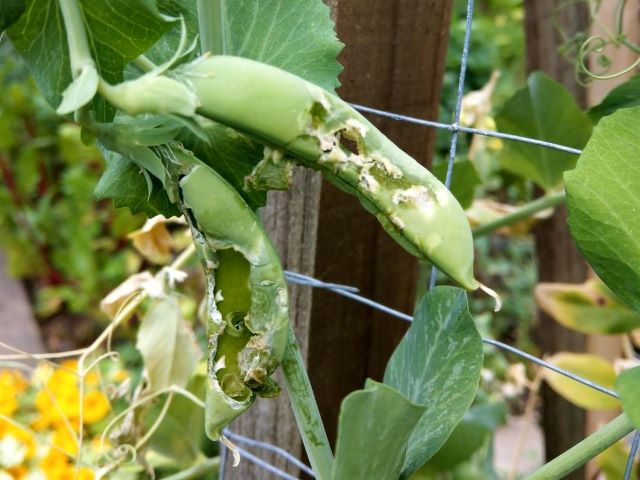
If something is eating your sugar snap peas, the most probable culprits are aphids, cutworms, armyworms, cucumber beetles, weevils, leaf miners, birds, or small animals.
Let’s find out more details about each pest eating your sugar snap peas and how you can get rid of them.
We’ll also touch on pea plant diseases that may be affecting your sugar snap pea crop from making it to harvest time.
Table of Contents
- Aphids Are Eating Your Sugar Snap Peas
- Leaf Miners Are Eating Your Sugar Snap Peas
- Pea Weevils Are Eating Your Sugar Snap Peas
- Pea Moths Are Eating Your Sugar Snap Peas
- Cucumber Beetles Are Eating Your Sugar Snap Peas
- Cutworms are Eating Your Sugar Snap Peas
- Armyworms are Eating Your Sugar Snap Peas
- Birds or Animals Are Eating Your Sugar Snap Peas
- Diseases Destroying Sugar Snap Pea Plants
Aphids Are Eating Your Sugar Snap Peas
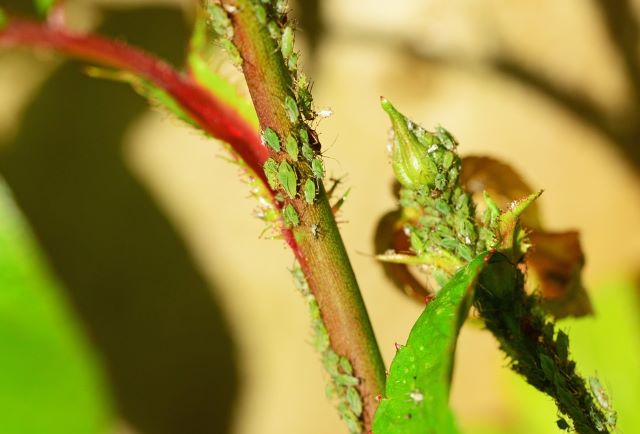
Aphids are tiny insects that feed on many garden plants including sugar snap peas. Once an aphid colony has started, they multiply quickly, so you need to remedy the situation if you intend on saving your peas.
Dealing with an aphid infestation can be annoying because they are very tiny and usually hide on the underside of the plant leaves. You might not even see them until there are a lot of them. Then you’ll know aphids are present from the damage done to your sugar snap peas.
There are a few clues to look out for aphids. I look for a colony of ants. Aphids and ants have a well-known and interesting symbiotic relationship called mutualism. Do you remember from grade school science class? Ants use the aphids and herd them into colonies.
I also look for drooping leaves to identify an aphid problem. This isn’t conclusive, but it’s a clue. Aphids live on the underside of the leaves. If there’s a large enough colony of aphids and ants, the leaves will sag.
Solutions for Aphids
If something is eating your sugar snap peas, you should do everything to save them. Try these solutions to get rid of aphids.
- Use a hose to spray the aphids off. You don’t want to destroy the sugar snap pea plant, so spray the plant gently. A good spray might be what you need to save your sugar snap peas.
- Insecticidal soap is also safe to use on sugar snap pea plants and will help remove aphids.
- Make a solution of neem oil like this one and water. Neem oil is a well-documented enemy to insects, bacteria, and fungus. Add the neem oil solution to your plant to treat the infestation.
- Add biological controls. Ladybugs and other beneficial prey on aphids. Having a diverse garden helps attract insects that will help you to garden naturally and organically.
Leaf Miners Are Eating Your Sugar Snap Peas
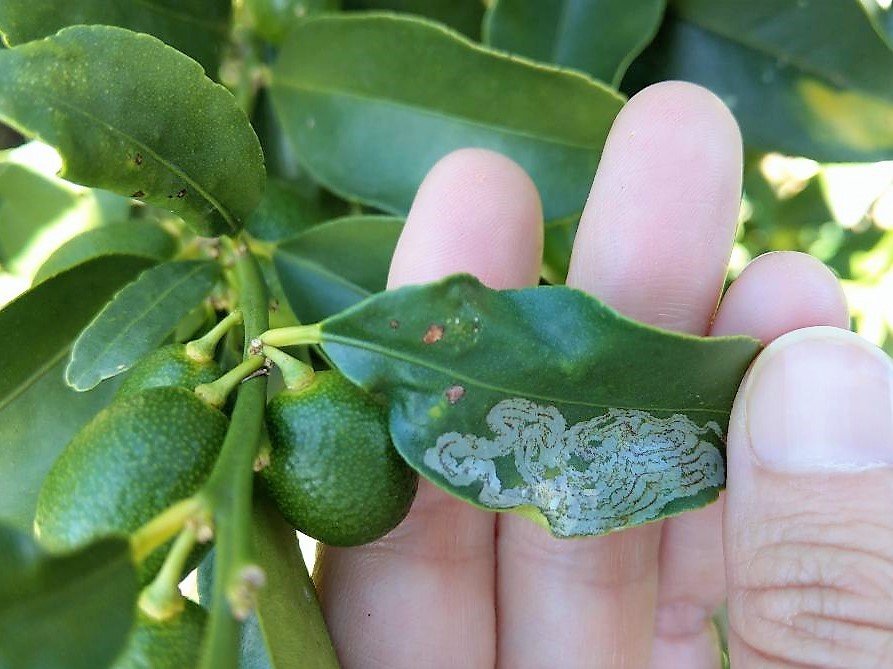
Leaf miners are larvae that dig holes through the leaves of numerous plant species. Pictured above is leaf miner damage to my kumquat tree. They create a trial-like pattern in the leaves. And Leaf Miners may be eating the leaves of your sugar snap peas. If you notice any damage to the leaves, consider leaf miners as suspects.
Solutions for Leaf Miners
You’re in luck because the solution to a leaf miner invasion is similar to the aphid solution, so if you misidentify the culprit you’re still likely to treat the problem. I recommend taking action swiftly to get the problem under control before a serious infestation begins.
- Make a solution of neem oil and water. As I mentioned previously, neem oil is great for controlling a number of pests.
- Add biological controls. Ladybugs and several other insects feed on leaf miners.
There is a chance that the culprits are actually thrips, a small black insect, or Spider Mites, a tiny insect with a red body. The neem oil spray mentioned is effective for treating both of these pests. Additionally, ladybugs are a natural predator to thrips and spider mites.
Pea Weevils Are Eating Your Sugar Snap Peas
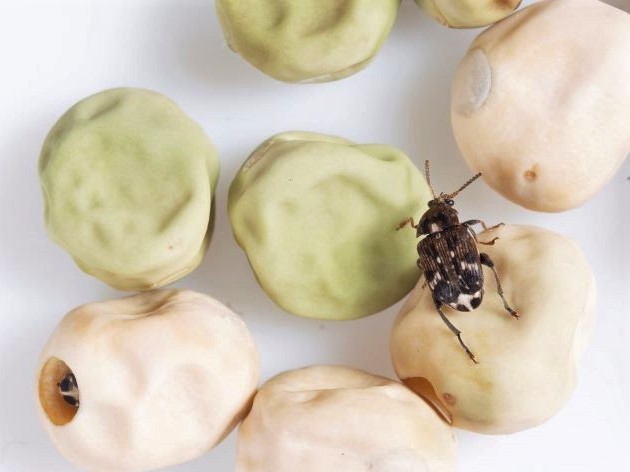
Pea weevils are not actually weevils; they’re beetles! The adult pea weevils are pretty easy to spot. Both the adults and larvae destroy parts of the plant’s leaves.
Solutions for Pea Weevils
- Prevent any future infestations by cleaning and disposing of debris.
- Use diatomaceous earth around the soil of the sugar snap pea plants.
- Use sticky traps like these.
- Practice crop rotation.
- Bay leaves repel pea weevils so if you have a potted bay tree, consider placing it near your sugar snap pea plants.
Pea Moths Are Eating Your Sugar Snap Peas
Pea moths are a type of flying insect that lays their eggs on the pea plant. The eggs hatch and become larvae that feed on the sugar peas. Getting rid of a pea moth problem is simple – protect the leaves from the larvae and keep the moths off the plant.
Solutions for Pea Moths
- Cover your sugar snap pea plants with insect-proof mesh.
- Spray the leaves with horticultural neem oil which is safe for organic gardening practices.
Cucumber Beetles Are Eating Your Sugar Snap Peas
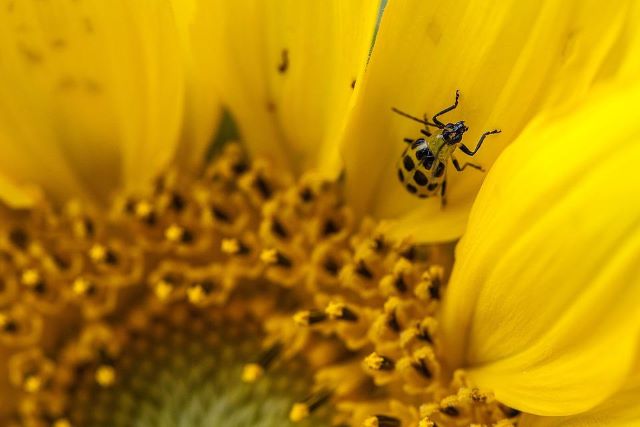
Cucumber beetles are yellow, green or brown and spotted with black dots or stripes. If only they weren’t a nemesis to my sugar snap peas!
Cucumber beetles feed on the roots and leaves of the plant, effectively preventing the plant from growing.
Solutions for Cucumber Beetles
- Use insect-proof netting to cover your plants.
- Add biological controls, such as beneficial insects like ladybugs or green lacewings.
- Use Horticultural Neem Oil to deter cucumber beetles.
Cutworms are Eating Your Sugar Snap Peas
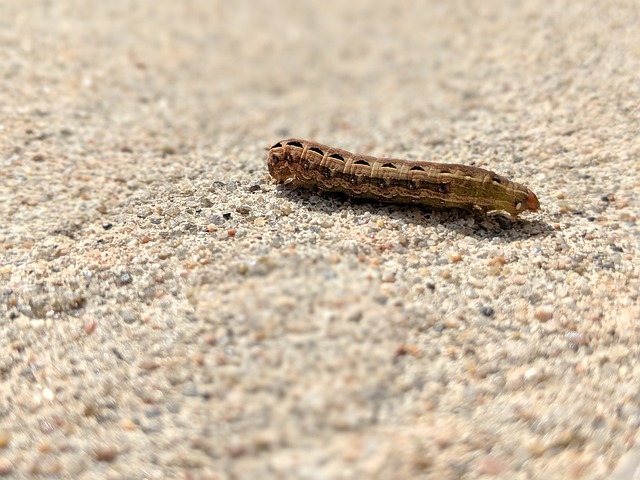
Cutworms can be identified by their tendency to coil up into a C shape when threatened. They favor nighttime activity so if you are up for picking them off by hand, you’ll need your flashlight handy.
Otherwise, check your sugar snap pea plants in the morning. Cutworms feed off and destroy the stems of sugar snap pea plants, so they can be fatal to the plant. Seedlings are particularly vulnerable to cutworm attacks.
Solutions for Cutworms
- Remove cutworm larvae from the soil by hand. (They are active at night).
- Add biological controls such as beneficial nematodes.
- Use diatomaceous earth around the base of sugar snap pea plants to deter or kill inquisitive cutworms.
- Use an organic pesticide. I favor the above methods before using pesticides, even organic ones.
Armyworms are Eating Your Sugar Snap Peas
Armyworms are similar to cutworms. They are the larvae of moths and can feed on sugar snap peas. The solution to Armyworms is similar to cutworms, so if you are unsure which is the problem – try any of these solutions.
Solutions for Armyworms
- Remove the worms from the soil by hand and crush them.
- Encourage beneficial insects in your garden.
- Use diatomaceous earth around the base of the plant.
- Lastly, use an organic pesticide.
Birds or Animals Are Eating Your Sugar Snap Peas
Your sugar snap peas may be getting attacked from above or on the ground by a hungry animal. Birds, squirrels, deer, and other woodland creatures love sugar snap peas.
If you suspect that your sugar snap peas are getting eaten by animals or birds, the solution is simple and effective. You do not need to consider pesticides or harsh chemicals.
Solutions for Birds and Animals
- Make noise to scare the birds away. Consider whistles, radios or other noisemakers. For example, foil baking trays tied to a tree branch or fence. When the wind blows, the trays make noise and effectively scare away animals (and probably your peace and quiet, so use with caution!).
- Use netting or mesh to cover your sugar snap pea plants.
- Buy a scarecrow. An Owl Scarecrow like this one is effective.
- Use reflective tape specially designed for keeping birds off plants and any unwanted places.
- Use a hot pepper spray on your plants. Capsaicin, the chemical compound found in spicy foods, is a natural deterrent to animals.
- Orange or peppermint oil are deterrents for animals.
Diseases Destroying Sugar Snap Pea Plants
Every seasoned gardener knows that plants can get sick, just like us. Fungi, viruses, and bacteria can make their home in our vegetable gardens. If your sugar snap pea plants aren’t growing, it might not be because something is eating them.
Bacteria or fungi may have spoiled your sugar snap pea plants, preventing them from reaching your dinner table. When it comes to peas, the culprit isn’t always visible to the naked eye.
There are several different types of bacteria and fungi that may be to blame. Whatever the exact culprit is, once your pea plant is infected, the solution is usually fungicides or neem oil.
Neem oil has been demonstrated to treat Downy and Powdery mildew, two types of fungi that might be destroying your plant. I already described in detail how to make a neem oil solution since the oil can also be used to treat so many other infestations.
It’s best to prevent infection in the first place by crop rotation and removal of debris.
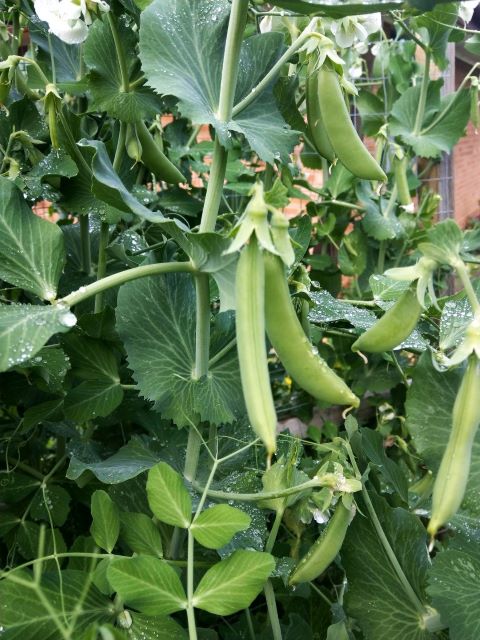
Further reading:
- How To Grow Sugar Snap Peas: Growing Guide And Tips
- DIY Trellis For Cucumbers (Step-By-Step With Pictures)
- 7 Reasons Why Your Green Bean Plants Are Turning Yellow
- What’s Eating My Broccoli? (And how to get rid of them!)
- 7 Reasons Globe Artichokes Are Small (With Solutions)
- Bean Plants Dying? 7 Causes and Solutions
